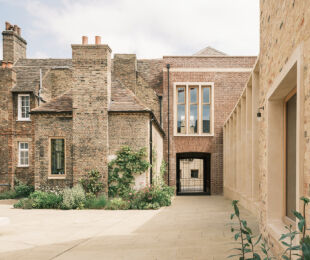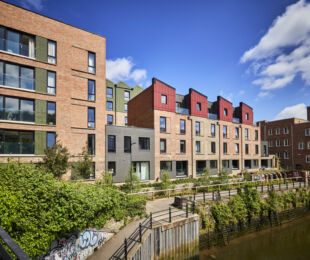
Designed by Levitt Bernstein, the Turberville Building is the first significant project in half a century to be undertaken at Eltham College, an independent school in Mottingham, south-east London. Replacing a run-down 1960s wing, the new block provides a new sixth form centre and maths and languages departments, with a range of teaching, study, seminar and social spaces arranged over three storeys.
Located adjacent to the locally-listed main school building and defining the fourth side of the school’s historic main quad, the design responds to this sensitive context with a modern interpretation of classical architecture. The new brick facades with precast stone features complement those of the surrounding buildings, with anodised aluminium detailing used to articulate the meeting of old and new. The elevation facing the quad features a single-storey colonnade, providing continuity with an existing colonnade, but with contrasting, lozenge-shaped columns. The roof line matches the neighbouring two-storey buildings, but with set-back dormers to the second-floor accommodation. The more imposing elevation facing the playing fields is expressed as three full storeys in carefully proportioned brickwork, stone and window detailing. The sixth form centre projects from this facade into the landscape to create the heart of the building, its identity marked by a cast stone column and beam grid.
The bricks for the Turberville Building were selected to complement the golden tones of the bricks of the original school buildings that form the remaining three sides of the quad.The bonding is generally half-lap stretcher, but with stacking and rotating of standard size bricks used to define window bays. The new colonnade comprises brick columns, lozenge-shaped in plan, is formed of two different radial brick specials. This ergonomic ‘softening’ of the column corners was designed to encourage movement in and around them. The column positions are reflected in the main facade behind by piers of stacked stretchers and headers.
The scale of the facade facing the sports pitches is tempered and given proportion by forming window bays using piers of stacked headers and stretchers standing proud of the elevation. Spandrels are formed of rotated, stacked headers between the windows and the bay topped with stacked soldier coursing.
A triple-height, central glazed atrium provides an entrance and focal point for the whole school, with a visual and physical link between the quad and playing fields. The sixth form centre sits directly adjacent to this, visible to all students. The building is predominantly naturally ventilated, with anodised perforated panels adjacent to windows to provide a decorative cover to the ventilation louvres of each classroom. The central corridors and atrium provide the passive path for air flow. A new combined heat and power system and photovoltaic roof panels also meet the long-term sustainability aspirations of the school.
The quad has been re-landscaped with paving and bonded gravel defining the colonnade and entry points. The central lawn has been raised to create seating areas around the perimeter; add to the classical aesthetic and emphasise the heart of the school. A new landscaped setting to the west improves access to the playing fields and wider estate and knits the new buildings into their setting.






